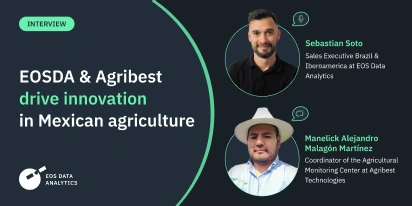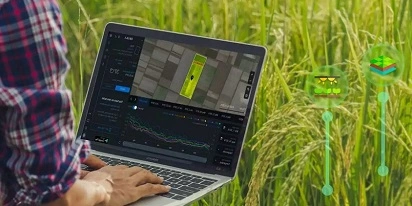
Boosting Latin America: Agritech And Advisory
The great importance of Latin American farming to society is undeniable. Besides generating agricultural produce to meet increasing food demand, the farm sector also employs many people ensuring the social and economic development of the region. Now, farming businesses have started utilizing new technologies and services, aspiring to improve agricultural productivity and bring farming to a new orbit.
We talked to Dmytro Svyrydenko, Business Development Manager at EOS Data Analytics, about the agricultural challenges and opportunities in Latin America, the role and value of farming advisors, and the future of satellite data and EOSDA Crop Monitoring platforms in the region.
What Is The Role And Performance Of Latin America’s Agriculture?
Agriculture is a significant driver of the region’s economy, accounting for 5%–18% of gross domestic product. Latin American farmers grow various crops, such as soybeans, wheat, corn, and rice, contributing to agrobiodiversity. However, there is the flip side of the coin. Agriculture consumes around 75% of Latin American water resources and is responsible for 50% of greenhouse gas emissions. Even though farming delivers significant results, it costs high to the environment, and this fact urges agri-engaged businesses and communities to seek ways to improve agricultural operations.
What Are Those Challenges The Latin American Agricultural Sector Faces?
One of the biggest issues Latin America faces is changes in weather patterns induced by climate change. High temperatures, droughts, or tropical cyclones are those climatic problems Latin American agriculture has to deal with. For example, Brazil, Argentina, and Paraguay are experiencing prolonged drought periods this year which may seriously affect yields.
Besides challenging climate conditions, the region lacks modern agricultural equipment and has little access to digital technology due to limited Internet access, especially in rural areas. This situation deteriorates even more without qualified agri-specialists who can support smallholding and mid-size farmers in their daily struggles for better yields.
And What Are The Opportunities Agriculture Of Latin America Has?
The Latin American region has huge agricultural potential that can be unleashed with the help of precision farming technologies. The access to, let’s say, weather forecasts, precipitation, and soil moisture data may dramatically reshape the current crop growing strategy.
Also, understanding of soil fertility and temperature patterns will help cultivate crops in new locations and mitigate unfavorable climate conditions.
What Is the Latin American Precision Agriculture Market Capacity?
The region’s agritech market was valued at $1.21 billion in 2021, with an expected growth of up to $2.13 billion in 2026. Fueled by the global food demand, agricultural industries in many countries worldwide are currently accelerating production, leveraging technologies to improve effectiveness while preserving the environment.
Today, Latin America receives around 1% of agritech venture investments, leaving much room for further growth. The main reasons making the Latin American agricultural market attractive to tech investments are increasing food demand that will prompt the region to amplify its agricultural output up to an expected 25% in global food export by 2028 and the need for crop yield improvement with minimum impact on the environment.
What Digital Tools Does Precision Agriculture Use?
Modern precision agriculture techniques can be roughly divided into three streams: collecting information through drones or sensors and incorporating the data into management systems, utilizing climate indicators and risk management tools, and employing drones for fertilizer spraying to avoid excessive chemical usage.
And one more important thing is the technical staff who can properly analyze the information and help growers choose the best solution among the available options.
How May Agritech Help Farmers In Their Daily Operations?
Agricultural activities require close attention and a deliberate approach to be successful. Farmers often face the situation when poor understanding of soil fertility, insufficient or excessive fertilizing, and lack of timely information from fields limit farms’ productivity and reduce cropping ability. Agritech, including satellite monitoring technologies, provides reliable close-to-real-time field data for making informed decisions that will result in better yields and higher profits. Also, utilizing satellite platforms can tremendously facilitate farming advisors’ tasks delivering valuable insights to work with.
Who Are Farming Advisors, And What Functions Do They Perform?
Usually, farming advisors or agricultural consultants are agronomic engineers who diagnose fields to optimize the use of resources — fertilizers and variable rate correctives — and achieve economically and ecologically sustainable yields.
Typical stages of agricultural consultancy include:
- Field investigation and diagnostics covering soil and vegetation state analysis;
- Specific recommendations based on the findings;
- Monitoring of changes after recommendations are implemented;
- Results evaluation and strategy adjustment if necessary.
Join the EOSDA Partner Program
What Problems Can Agricultural Consultants Handle?
The common issues farmers encounter in their operations are:
- Acidic soils with imbalanced nutrients content;
- High fertilization and soil improvement costs;
- Difficulties in the use of variable rate correctives;
- Unsatisfactory soil productivity;
- Yield losses (up to 50%–70%);
- Ineffective farm management.
These challenges and many more can be effectively resolved by applying for agricultural consultancy.
What Methods And Tools Do Farming Advisors Use To Support Growers?
Consultants provide their clients with information technology and laboratory services and assist in the rational use of fertilizers and variable rate correctives, eventually leading to farms’ productivity and profitability growth.
I would say that consultants are a sort of benchmark setting high standards in delivering physicochemical and biological analyses, research, and training, recognized for quality, reliability, and innovations.
In Your Opinion, Will Satellite Tech Be Widely Adopted By Farming Advisors (And Farmers) In Latin America?
I’m confident it’ll happen. First, satellite and meteorological data are valuable information sources for smart decision-making. Then, satellite-based EOSDA Crop Monitoring platforms are a handy tool. You should just set priorities, synchronize all team members, and track tasks’ performance at your convenience — either from the office or in the field. And finally, utilizing remote sensing technologies may become an effective time- and cost-saving solution for Latin American growers and consultants.
How May EOSDA Solutions Help Farming Advisors Improve Their Services?
An online satellite-based precision agriculture platform for near-real-time field monitoring by EOSDA, can be useful to farming advisors in many ways.
The platform’s rich functionality offers:
- 24-hour remote access to all fields;
- Mobile application for scouts to detect and eliminate issues early on;
- Group accounts, ensuring transparent communication between farmers, scouts, and consultants;
- Vegetation indices and field productivity historical data for informed decision-making;
- Automatic notifications on changes in crop state to reduce yield loss risk;
- VRA (Variable Rate Application) maps to enhance sowing and fertilizing.
What Outcome Will Producers Have From Implementing Satellite-Driven Precision Ag Platforms Like Ours?
First and foremost, EOSDA Crop Monitoring solutions assist growers in optimizing costs, simplifying farm management, and improving productivity. Consequently, higher yields and lower input costs positively affect profitability. In the context of agritech solutions, satellite technologies can be rightfully called a Swiss Army knife for both farmers and agricultural consultants.
About the author:
Natalia Borotkanych has a PhD in space history, Master’s Degree in Foreign Policy from the Diplomatic Academy of Ukraine, as well as Master’s Degree in Public Management and Administration from National Academy for Public Administration under the President of Ukraine. Natalia's experience includes working in business, science, education, and government projects for over 15 years.
Recent articles

Transition Guide From Sentinel Hub EO Browser To EOSDA LandViewer
Need an EO Browser alternative that’s just as familiar but more flexible? EOSDA LandViewer offers free recent imagery, a vast satellite data archive, and advanced analytical tools.

EOSDA & Agribest: Driving Agtech Growth In Mexico
In this insightful interview, Agribest shares how its collaboration with EOSDA is shaping Mexico’s agricultural future, with a focus on profitability, sustainability, and technology.

Top Ready-Made Agriculture Tools & Softwares for 2025
Agriculture softwares are silent partners in the field, working tirelessly behind the scenes to support farmers with insights and precision to cultivate sustainable agricultural ecosystems.